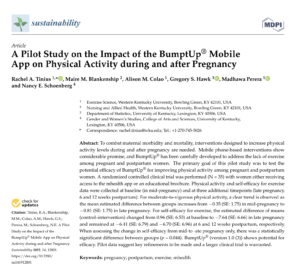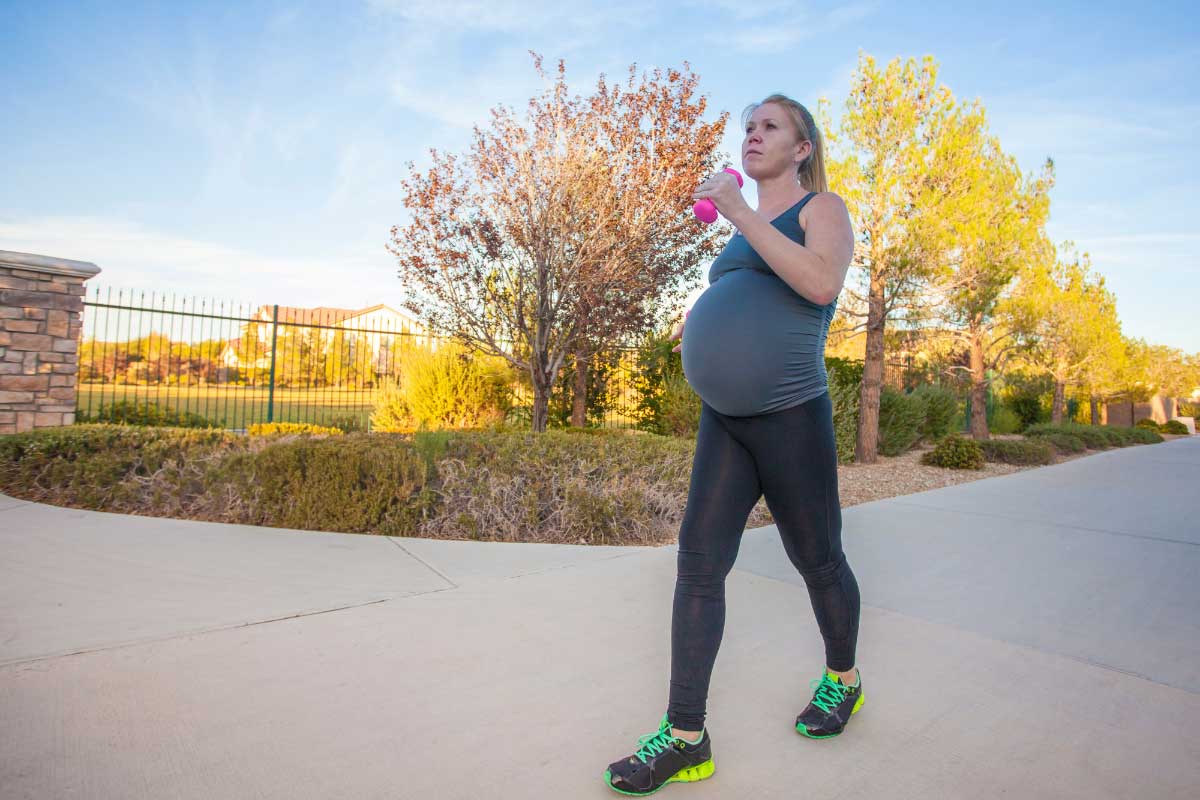Abstract: To combat maternal morbidity and mortality, interventions designed to increase physical activity levels during and after pregnancy are needed. Mobile phone-based interventions show considerable promise, and BumptUp® has been carefully developed to address the lack of exercise among pregnant and postpartum women.
The primary goal of this pilot study was to test the potential efficacy of BumptUp® for improving physical activity among pregnant and postpartum women. A randomized controlled clinical trial was performed (N = 35) with women either receiving access to the mhealth app or an educational brochure. Physical activity and self-efficacy for exercise data were collected at baseline (in mid-pregnancy) and at three additional timepoints (late pregnancy, 6 and 12 weeks postpartum). For moderate-to-vigorous physical activity, a clear trend is observed as the mean estimated difference between groups increases from −0.35 (SE: 1.75) in mid-pregnancy to −0.81 (SE: 1.75) in late pregnancy. For self-efficacy for exercise, the estimated difference of means (control–intervention) changed from 0.96 (SE: 6.53) at baseline to −7.64 (SE: 6.66) in late pregnancy and remained at −6.41 (SE: 6.79) and −6.70 (SE: 6.96) at 6 and 12 weeks postpartum, respectively. When assessing the change in self-efficacy from mid-to -ate pregnancy only, there was a statistically significant difference between groups (p = 0.044). BumptUp® (version 1.0 (3)) shows potential for efficacy. Pilot data suggest key refinements to be made and a larger clinical trial is warranted.
Introduction
Maternal mortality and morbidity rates are strikingly high in the U.S. compared to other industrialized countries [1]. A contributing factor is the large number of women presenting for prenatal care with chronic health conditions including obesity, hypertension, and diabetes, all of which lead to complicated pregnancies [2], and women in certain marginalized groups may be even more vulnerable to chronic health conditions and have less access to prenatal care than women in other settings [3,4].
Physical activity during and after pregnancy contributes to better/optimal maternal health outcomes including reduced weight gain, improved glucose control, lower blood pressure, and better mental health [5]. Despite these well-documented findings, there are few sustainable, scalable, and accessible interventions that can successfully increase physical activity and reduce gestational weight gain, particularly among underserved women.
Mobile phone-based interventions show considerable promise because they can be tailored to the target population, can be delivered at any place and at any time, are interactive,
and are accessible to the majority of the population irrespective of socioeconomic status (96% of U.S. women aged 18–49 have smartphones) [6,7]. Previous research demonstrates the ability of mobile apps to positively impact physical activity behaviors [8]; thus, a unique
Publisher’s Note: MDPI stays neutral with regard to jurisdictional claims in published maps and institutional affiliations.
and timely opportunity exists to increase physical activity among pregnant and postpartum
women through mobile health apps.
Mobile apps have emerged as a primary mode of health information for women during pregnancy [9]. In fact, pregnancy is the medical condition with the highest number of apps available [9]. However, to our knowledge, mobile apps designed specifically to increase physical activity during pregnancy are sparse [8,10,11]. Mobile apps designed to alter lifestyle during pregnancy have been unable to elicit statistically significant differences in physical activity among intervention vs. control groups of pregnant women [12–14]. In addition, many focus more on weight status and diet than physical activity [12,13,15]. Ainscough et al. focused on the impact of a mobile health program for overweight and obese pregnant women and found some improvements among physical activity variables in the intervention arm [15]; however, the intervention contained limited physical activity guidance (i.e., no personalized programming) and physical activity was measured via self-report, which is a major limitation. Several recent reviews concluded that exercise apps designed for pregnancy fail to consider: (1) current evidence-based physical activity guidelines, (2) screening for contraindications to physical activity, (3) appropriate personalization features to account for an individual’s characteristics, and (4) the involvement of qualified experts during the development of the app [10,11].
Akin to the postpartum focus on infant care rather than maternal health [16], a limitation to nearly all of the aforementioned mobile apps is the lack of continuation of physical activity support during the postpartum period [8]. Over 50% of maternal deaths occur between 7 and 365 days postpartum, many of which are related to factors modifiable with physical activity (i.e., obesity, diabetes, hypertension, and mental health) [4]. Given that pregnancy is an important opportunity for making lasting lifestyle changes [17], and keeping women engaged through postpartum can help with long-term adherence, the
development of an mHealth app that also assists women through the postpartum period is critical.
To address these gaps, our team has engaged in extensive preliminary studies including focus groups and interviews with pregnant women, postpartum women, and obstetric health care providers [18] in order to develop an acceptable and promising approach to increase physical activities during and after pregnancy. Key features identified from these sessions and integrated into the development of a mobile health app (BumptUp®) include progress tracking, social support, evidence-based and safe exercise programming, videos, and symptom tracking [18], and these features set apart BumptUp® from existing mobile health interventions for pregnant and postpartum women. The primary goal of this pilot
study was to test the efficacy of BumptUp® for improving physical
View our full article here.
Authors
Rachel A. Tinius 1,* , Maire M. Blankenship 2, Alison M. Colao 1, Gregory S. Hawk 3, Madhawa Perera 1 and Nancy E. Schoenberg 4
Copyright: © 2022 by the authors.
Licensee MDPI, Basel, Switzerland. This article is an open access article distributed under the terms and
conditions of the Creative Commons Attribution (CC BY) license (https://creativecommons.org/licenses/by/4.0/).

